CBSE Sample Question Paper (2022-23) - 7 | Geography Class 11 - Humanities/Arts PDF Download
Time Allowed: 2 hours
Maximum Marks: 80
General Instructions:
- All questions are compulsory.
- Question number 1 to 14 are Multiple choice questions carrying 1 mark each.
- Question number 15 to 16 are Multiple source-based questions carrying 3 marks each.
- Question number 17 to 21 are Short-answer questions carrying 3 marks each. Answer to each of these questions should not exceed 80-100 words.
- Question number 22 to 26 are Long-answer questions carrying 5 marks each. Answer to each of these questions should not exceed 150 words.
- Question number 27 and 28 are related to the identification or locating and labeling of geographical features on maps, carrying 5 marks each.
Q1. Each element of the physical geography is important for: [1]
(a) human beings
(b) survival
(c) universe
(d) plants
Ans: (a) human beings
Q2. The earth has a _______structure. [1]
(a) layered
(b) non-layered
(c) piled on
(d) single
Ans: (a) layered
Q3. _______Volcanoes are characterised by eruptions of cooler and more viscous lavas than basalt. [1]
(a) Intrinsic
(b) Composite
(c) Caldera
(d) Nife
Ans: (b) Composite
Q4. The sediments on the ocean floor are unexpectedly very: [1]
(a) thick
(b) polluted
(c) thin
(d) fine
Ans: (c) thin
Q5. Foliated rocks and non-foliated rocks are classifications of: [1]
(a) Igneous rocks
(b) Metamorphic rocks
(c) Sedimentary rocks
(d) Crystal rocks
Ans: (b) Metamorphic rocks
Q6. Thermal expansion and pressure release lead to A [1]
(a) physical weathering
(b) hydration
(c) carbonation
(d) denudation
Ans: (a) physical weathering
Q7. Which one of the following materials is affected by the hydration process: [1]
(a) Granite
(b) Clay
(c) Quartz
(d) Salts
Ans:
(d) Salts
Q8. _______is one of the two dominant agents in hot deserts. [1]
(a) Wind
(b) Water
(c) Pediplain
(d) Salt
Ans:
(a) Wind
Q9. _______acts like a blanket allowing the earth neither to become too cold nor too hot. [1]
(a) Dust particles
(b) Water vapor
(c) Ozone layer
(d) Carbon dioxide
Ans:
(b) Water vapor
Q10. The insolation received by the Earth is in: [1]
(a) long waves forms
(b) short waves forms
(c) medium waves forms
(d) wide waves forms
Ans:
(b) short waves forms
Q11. Coriolis Forces blow parallel to the: [1]
(a) hemispheres
(b) poles
(c) isobars
(d) poles
Ans:
(c) isobars
Q12. Arrange the Water Cycle in the correct order: [1]
(i) Water condenses to form clouds
(ii) Liquid water evaporates into water vapors
(iii) Precipitates back to earth
(iv) Falls in form of rain and snow
Options:
(a) i, ii, iii, iv
(b) iv, ii, iii, i
(c) ii, i, iii, iv
(d) iii, i, ii, iv
Ans:
(c) ii, i, iii, iv
Q13. The rain caused by cyclonic activity is known as [1]
(a) cyclonic rain
(b) hydraulic rain
(c) conventional rain
(d) orographic rain
Ans:
(a) cyclonic rain
Q14. Match and arrange Descriptor Magnitudes in the correct order: [1]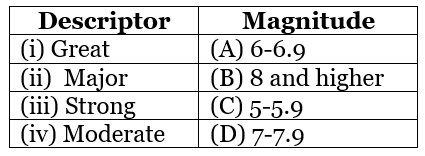 Option :
Option :
(a) i-B, ii-D, iii-A, iv-C
(b) i-C, ii-A, iii-D, iv-B
(c) i-A, ii-D, iii-C, iv-B
(d) i-D, ii-C, iii-B, iv-A
Ans:
(a) i-B, ii-D, iii-A, iv-C
Q15. Read the case study given below and answer any three of the questions that follow.
The speed of waves in the ocean depends upon the depth of the water. It is more in shallow water than in the ocean deep. As a result of this, the impact of tsunamis is less over the ocean and more near the coast where they cause large-scale devastations. Therefore, a ship at sea is not much affected by tsunamis and it is difficult to detect a tsunami in the deeper parts of the sea. It is so because over deep water tsunamis have very long wavelengths and limited wave height.
Thus, a tsunami wave raises the ship only a meter or two and each rise and fall takes several minutes. As opposed to this, when a tsunami enters shallow water, its wavelength gets reduced and the period remains unchanged, which increases the wave height. Sometimes, this height can be up to 15 m or more, which causes large-scale destruction along the shores. Thus, these are also called Shallow Water Waves.
Tsunamis are frequently observed along the Pacific Ring of Fire, particularly along the coast of Alaska, Japan, the Philippines, and other islands in Southeast Asia, Indonesia, Malaysia, Myanmar, Sri Lanka, India, etc. After reaching the coast, the tsunami waves release enormous energy stored in them and water flows turbulently onto the land destroying port cities and towns, structures, buildings, and other settlements. Since the coastal areas are densely populated the world over, and these are also centers of intense human activity, the loss of life and property is likely to be much higher by a tsunami as compared to other natural hazards in the coastal areas.
(i) The speed of waves in the ocean depends upon the: [1]
(a) depth of water
(b) depth of sea bed
(c) depth of rocks
(d) depth of waves
Ans: (a) depth of water
(ii) When a tsunami enters shallow water, its wavelength gets reduced and the wave-height_______. [1]
(a) decreases
(b) increases
(c) remains unchanged
(d) None of the above
Ans: (b) increases
(iii) After reaching the coast, the tsunami waves release enormous_______stored in them. [1]
(a) power
(b) destruction
(c) energy
(d) grid
Ans: (c) energy
Q16. Read the case study given below and answer any three of the questions that follow.
The temperature of the world is significantly increasing. Carbon dioxide produced by human activities is a major source of concern. This gas, released into the atmosphere in large quantities by burning fossil fuel, is increasing gradually. Other gases like methane, chlorofluorocarbons, and nitrous oxide which are present in much smaller concentrations in the atmosphere, together with carbon dioxide are known as green house gases.
these gases are better absorbers of long wave radiations than carbon dioxide, and so, are more effective at enhancing the greenhouse effect. These gases have been contributing to global warming. It is said that due to global warming the polar ice caps and mountain glaciers would melt and the amount of water in the oceans would increase. The mean annual surface temperature of the earth in the past 150 years has increased. It is projected that by the year 2,100, global temperature will increase by about 2°C.
This rise in temperature will cause many other changes: one of these is a rise in sea level, as a result of the melting of glaciers and sea ice due to warming. According to the current prediction, on average, the sea level will rise 48 cm by the end of the twenty-first century. This would increase the incidence of annual flooding. The climatic change would promote insect-borne diseases like malaria, and lead to shifts in climatic boundaries, making some regions wetter and others drier. The agricultural pattern would shift and the human population as well as the ecosystem would experience change.
(i) Methane, chlorofluorocarbons, and nitrous oxide along with carbon dioxide are known as [1]
(a) greenhouse gases
(b) combustion gases
(c) liquid gases
(d) solid gases
Ans: (a) greenhouse gases
(ii) Which gas is a better absorber of long-wave radiations? [1]
(a) Carbon dioxide
(b) Methane
(c) Oxygen
(d) Helium
Ans: (b) Methane
(iii)According to the current prediction, on average, the sea level will rise_______cm by the end of the twenty-first century. [1]
(a) 46
(b) 48
(c) 50
(d) 52
Ans:
(b) 48
Q17. Why has the Continental Drift Theory been discarded? [3]
Ans: Arthur Holmes in the 1930s discussed the possibility of convection currents operating in the mantle portion. These currents are generated due to radioactive elements causing thermal differences in the mantle portion. Holmes argued that there exists a system of such currents in the entire mantle portion. This was an attempt to provide an explanation for the issue of force, based on which contemporary scientists discarded the continental drift theory.
Q18. Define the term ‘Front’. How many types of the front are there? Explain each of them. [3]
Ans: When two different air masses meet, the boundary zone between them is called a ‘Front’. There are four different types of front :
(1) Stationary front: When the front remains stationary, it is called a stationary front.
(2) Cold front: When the cold air moves towards the warm air mass, its contact zone is called the cold front.
(3) Warm front: When the warm air mass moves towards the cold air mass, its contact zone is called the warm front.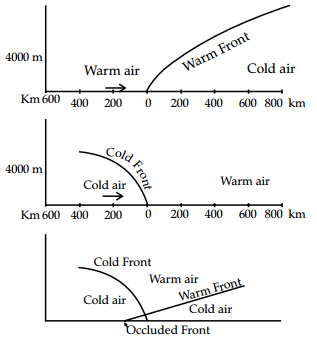
Q19. Describe any three characteristics of waves. [3]
Ans: The various characteristics of waves are:
(1) Wave crest and trough: The highest and lowest points of a wave are called crest and trough respectively.
(2) Wave height: It is the vertical distance from the bottom of a trough to the top of the crest of a wave.
(3) Wave amplitude: It is one-half of the wave height.
(4) Wave period: It is merely the time interval between two successive wave crests or troughs as they pass a fixed point.
(5) Wavelength: It is the horizontal distance between two successive crests.
(6) Wave speed: The wave moves through the water, and its speed is measured in knots.
(7) Wave frequency: It is the number of waves passing through a given point during a one-second time interval.
Q20. Why does India get a monsoon named as South-West Monsoon? [3]
Ans:
India gets a monsoon named as South-West Monsoon because:
(1) The low-pressure conditions by early June are powerful enough to attract the trade winds of the Southern hemisphere coming from the Indian Ocean. These South-East trade winds cross the equator and enter the Bay of Bengal and the Arabian Sea, only to be caught up in the air circulation over India.
(2) Passing over the equatorial warm currents, they bring with them moisture in abundance.
(3) After crossing the equator, they follow a Southwesterly direction and they are known as the Southwest monsoon.
Q21. How can we mitigate instances of landslides? [3]
Ans:
It is always advisable to adopt area-specific measures to deal with landslides.
(1) Restriction on the construction and other developmental activities such as roads and dams, limiting agriculture to valleys and areas with moderate slopes, and control on the development of large settlements in the high vulnerability zones, should be enforced.
(2) Some positive actions like promoting large-scale afforestation programmes and construction of bunds to reduce the flow of water should be taken.
(3) Terrace farming should be encouraged in the North-eastern hill areas.
Q22. How do natural calamities and illegal hunting harm biodiversity? [5]
Ans: Natural calamities such as Earthquakes, floods, volcanic eruptions, forest fires, droughts, etc., cause damage to the flora and fauna of the Earth, bringing change to the biodiversity of respective affected regions. Pesticides and other pollutants such as hydrocarbons and toxic heavy metals destroy the weak and sensitive species. Species, which are not the natural inhabitants of the local habitat but are introduced into the system are called exotic species. There are many examples when a natural biotic community of the ecosystem suffered extensive damage because of the introduction of exotic species.
During the last few decades, some animals like tigers, elephants, rhinoceros, crocodiles, minks, and birds were hunted mercilessly by poachers for their horn, tusks, hides, etc. It has resulted in the rendering of certain types of organisms as an endangered category. Illegal hunting and habitat destruction contributed to the second wave of extinction after European settlement including:
(i) 16 land birds (nine species and seven sub-species)
(ii) One of three native bat species
(iii) At least 12 invertebrates, such as snails and insects.
Q23. Write a note on the tributaries of the Indus River System. [5]
Ans: The tributaries of Indus:
(1) The Jhelum, an important tributary of the Indus, rises from a spring at Verinag, situated at the foot of the Pir Panjal in the South eastern part of the valley of Kashmir. It flows through Srinagar and the Wular Lake before entering Pakistan through a deep narrow gorge. It joins the Chenab near Jhang in Pakistan.
(2) The Chenab is the largest tributary of the Indus. It is formed by two streams, the Chandra and the Bhaga, which join at Tandi near Keylong in Himachal Pradesh. Hence, it is also known as Chandrabhaga. The river flows for 1,180 km before entering into Pakistan.
(3) The Ravi is another important tributary of the Indus. It rises West of the Rohtang Pass in the Kullu hills of Himachal Pradesh and flows through the Chamba valley of the state. Before entering Pakistan and joining the Chenab near Sarai Sidhu, it drains the area lying between the Southeastern part of the Pir Panjal and the Dhauladhar ranges.
(4) The Beas is another important tributary of the Indus, originating from the Beas Kund near the Rohtang Pass at an elevation of 4,000 m above the mean sea level. The river flows through the Kullu valley and forms gorges at Kati and Largi in the Dhauladhar range. It enters the Punjab plains where it meets the Satluj near Harike.
(5) The Satluj originates in the Raksas Tal near Mansarovar at an altitude of 4,555 m in Tibet where it is known as Langchen Khambab. It flows almost parallel to the Indus for about 400 km before entering India and comes out of a gorge at Rupar. It passes through the Shipki La on the Himalayan ranges and enters the Punjab plains. It is an antecedent river. It is a very important tributary as it feeds the canal system of the Bhakra Nangal Project.
Q24. How is the economic life in India affected by monsoons? [5]
Ans: (1) Monsoon is that axis around which revolves the entire agricultural cycle of India. It is because about 64% people of India depend on agriculture for their livelihood and agriculture itself is based on South-West monsoon.
(2) Except for the Himalayas, all the parts of the country have a temperature above the threshold level to grow crops or plants throughout the year.
(3) Regional variations in monsoon climate help in growing various types of crops.
(4) Variability of rainfall brings droughts or floods every year in some parts of the country.
(5) Agricultural prosperity of India depends very much on time and adequately distributed rainfall. If it fails, agriculture is adversely affected particularly in those regions where means of irrigation are not developed.
(6) Sudden monsoon burst creates the problem of soil erosion over large areas in India.
Q25. Mention the steps taken to conserve the soil. [5]
Ans: Soil erosion and exhaustion are caused by humans and at the same time humans can also prevent them. Soil conservation is a method to maintain soil fertility, prevent soil erosion and exhaustion, and improve the degraded condition of the soil. Soil erosion is essentially aggravated by faulty practices.
(1) The first step in any rational solution is to check open cultivable lands on slopes from farming.
(2) Lands with a slope gradient of 15–25% should not be used for cultivation. If at all the land is to be used for agriculture, terraces should carefully be made.
(3) Over-grazing and shifting cultivation in many parts of India have affected the natural cover of land and given rise to extensive erosion. It should be regulated and controlled by educating villagers about the consequences.
(4) Contour bunding, Contour terracing, regulated forestry, controlled grazing, cover cropping, mixed farming and crop rotation are some of the remedial measures which are often adopted to reduce soil erosion.
(5) Efforts should be made to prevent gully erosion and control their formation. Finger gullies can be eliminated by terracing. In bigger gullies, the erosive velocity of water may be reduced by constructing a series of check dams.
(6) Special attention should be made to control the headword extension of gullies. This can be done by gully plugging, terracing or by planting cover vegetation. In arid and semi-arid areas, efforts should be made to protect cultivable lands from encroachment by sand dunes through developing shelterbelts of trees and agro-forestry. Lands, not suitable for cultivation, should be converted into pastures for grazing. Experiments have been made to stabilise sand dunes in western Rajasthan by the Central Arid Zone Research Institute (CAZRI).
Q26. What is a vulnerability? Divide India into natural disaster vulnerability zones based on droughts and suggest some mitigation measures. [5]
Ans:
Vulnerability refers to the risk of becoming a victim to a disaster. Those areas that are more prone to natural calamities are more vulnerable: India can be divided into the following vulnerable regions :
(1) Extreme Drought Prone areas: It is evident that most parts of Rajasthan, particularly areas to the West of the Aravali hills, i.e., Marusthali and Kachchh regions of Gujarat fall in this category. Included here are also the districts like Jaisalmer and Barmer from the Indian desert that receive less than 90 mm average annual rainfall.
(2) Severe Drought Prone Areas: Parts of eastern Rajasthan, most parts of Madhya Pradesh, eastern parts of Maharashtra, interior parts of Andhra Pradesh and Karnataka Plateau, Northern parts of interior Tamil Nadu and Southern parts of Jharkhand and interior Odisha are included in this category.
(3) Moderate Drought Prone Areas: Northern parts of Rajasthan, Haryana, Southern districts of Uttar Pradesh, the remaining parts of Gujarat, Maharashtra except Konkan, Jharkhand and Coimbatore Plateau of Tamil Nadu and interior Karnataka are included in this category. The remaining parts of India can be considered either free or less prone to the drought.
Remedial measures:
- Provision for the distribution of safe drinking water, medicines for the victims and availability of fodder and water for the cattle and shifting of the people and their livestock to safer places, etc., are some steps that need to be taken immediately. Identification of groundwater potential in the form of aquifers, transfer of river water from the surplus to the deficit areas, and particularly planning for inter-linking of rivers and construction of reservoirs and dams, etc., should be given serious thought. Remote sensing and satellite imageries can be useful in identifying the possible river basins that can be interlinked and in identifying the groundwater potential.
- Dissemination of knowledge about drought-resistant crops and proper training to practice the same can be some of the long-term measures that will be helpful in drought mitigation. Rainwater harvesting can also be an effective method in minimizing the effects of drought.
Q27. In the given outline map of the world, there are five items marked as A, B, C, D, and E. Identify tire features with the help of information given below and write their correct names on the map: [5]
A. Hotspot
B. Major seaport of Asia
C. Major plate
D. Largest country in Asia (areawise)
E. Major airport of South America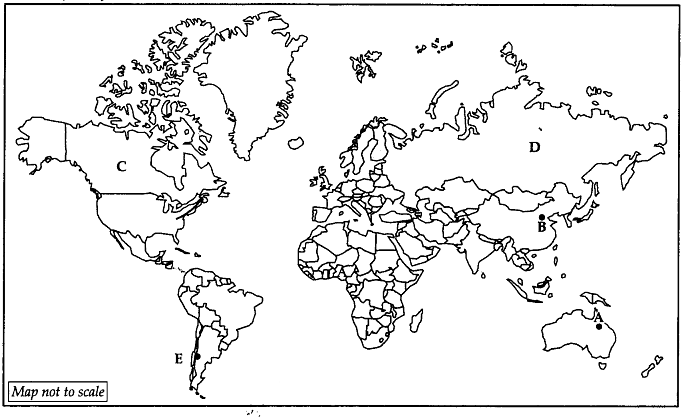 Ans:
Ans:

Q28. Locate and label the following on the political outline map of India: [5]
A. Iron ore mine
B. Manganese mine
C. A major seaport
D. Leading state of cotton production
E. A major international airport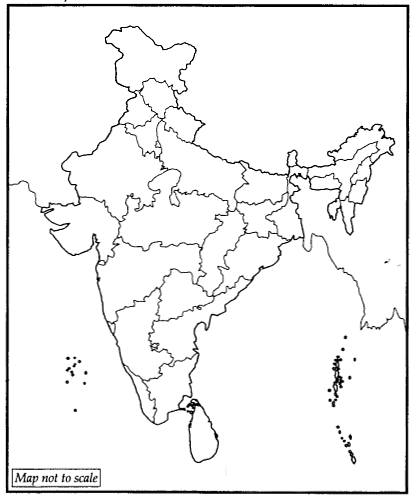 Ans:
Ans: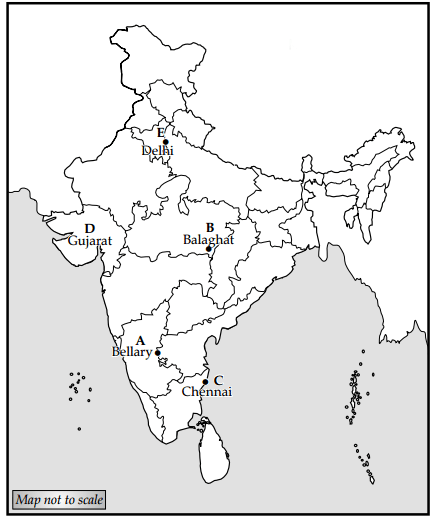
|
70 videos|289 docs|44 tests
|
















